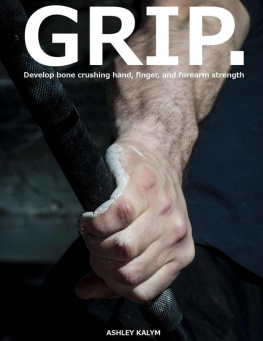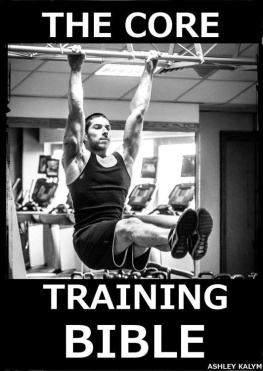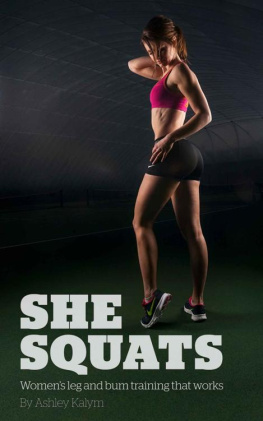GRIP
Grip training is one of the most undertrained aspects of many peoples training, and as such their entire routine suffers as a result.
The ability to hold onto barbells, dumbbells, or other competitors is vital if you want to achieve your athletic potential, whether that is powerlifting, bodybuilding, or sports that rely on huge grip strength, such as Rugby or Judo.
This eBook shows you how to develop all round grip strength, including exercises for the fingers, hands, wrists, and forearms.
Don't let your grip be the weak link in your chain, and start developing a bone-crushing grip right now!
Copyright 2012 Ashley Kalym
All rights reserved. No portion of this book, whether in print or electronic format, may be duplicated or transmitted without written permission of the publisher, except where permitted by law.
It seems crazy, but grip is one of the most vital areas of training, especially for the strength athlete, yet it garners almost zero attention. This is epitomised in almost any gym that you care to enter in the form of wrist straps and hooks, which enable people to lift more than their bodies are ready for.
If you are reading this book then you are hopefully curious about how grip strength impacts on nearly every aspect of physical performance, whether that is in a specific sport or just life in general. Your hands are the things that allow you to transfer power from the rest of your body to the object in question, whether that is a barbell, a pull-up bar, or another person.
Grip is the link between you and the exercise you are performing. Any pushing, any pulling, numerous core exercises, and many lower body exercises rely on the hands and the forearms to control and handle the weight that is being used to train the body. You can have the strongest core and upper body in the world, if your grip strength is not up to scratch then it is all for nothing. On the other hand, if a person with bone crushing grip strength gets hold of you it is very likely that you will be on the losing side.
Grip becomes much more important when participating in combat and contact sports such as MMA, Rugby, Judo, etc. In these sports, grip becomes of win or lose importance. A weak grip in a rugby or American football match could mean letting the opponent through to score that goal.
In terms of the most well known exercises that rely on huge grip strength, the deadlift and the pull-up are some well known examples. The deadlift is one of, if not the best exercise for training the back, and to a large extent, the lower body as well. Apart from the strength of the lower back and legs, to be successful at the deadlift the grip needs to be very well developed. In this regard the grip also acts as a safety mechanism. If your grip is not strong enough to hold onto the bar then your back should not be holding the weight. This is why I would advise against using straps and much less hooks for deadlifting.
To help train the grip there are a number of tools and pieces of equipment that we can use to make the task much more effective. Most of these pieces of equipment can be found in commercial gyms, and some can be found on the Internet. Even if you do have to buy some of the pieces in this list, they are not expensive by any means, and grip training will always be a vital part of your training, so they will not go to waste.
Pull-up bar
The pull-up bar is obviously used for pull-ups and their many variations, and these exercises on their own can be mastered to achieve awesome grip strength. In fact, the main problem when working with beginners on the pull-up bar is their lack of grip strength. In many cases they do have the strength to pull themselves up to the bar but lack the sufficient grip strength to hold themselves up there in the first place.
Pull-up bars can be found in most commercial gyms, and if you are not a member of a gym then they can be found relatively cheaply on the Internet or in sports shops. If you do invest in one then they can also be used to perform many other types of exercises. You can find more details on these in my other eBooks, The Pull-up Bible , and The Core Training Bible.
Gymnastic rings
For the false grip exercises gymnastic rings are an invaluable tools and can also be used for many other movements that are also featured in some of my other eBooks. Although the false grip can be performed on a pull-up bar and other apparatus, the curved shape of the ring lends itself very well to the hands and wrist position needed to
Barbell plates and dumbbells
Normally used for bench pressing, deadlifts, and other weighted movements; barbell plates can also be used for pinch grip training. You will always find plenty of these in commercial gyms, of varying sizes, types, and weights. Many different types of dumbbells can also be found in most gyms.

Chalk
Chalk basically dries out the hands and creates a more abrasive and stickier surface for the grip to work with. There are two main types of chalk and we will discuss both of them here. The first is the traditional powdered chalk that you may have seen being used by gymnasts, weightlifters, and climbers. This normally comes in large square blocks, which are then broken down and placed in a container of some kind. The downsides to this are many, including excess chalk on the floor and on the apparatus, chalk dust in the air which can be breathed in and make its way into the eyes, and the job of reapplying the chalk after a short period of time.
The second type is liquid chalk, which normally comes in a small bottle. Liquid chalk is the same compound as normal powdered chalk, except that a liquid is added that evaporates off the skin once it is applied. This leaves a thin layer of chalk over the surface of the palm of the hand, which makes grip on rings, pull-up bars, and barbells much stronger. Liquid chalk does also not have to be reapplied quite as often as powdered chalk, does not get into the air or your lungs or eyes, and can also be applied onto the wrists and other parts of the anatomy that powdered chalk cannot.
If you are a member of a gym then it is worth checking whether they allow chalk to be used on pull-up bars and barbells. If they dont, I would consider changing gyms, as they obviously care more about the state of their floors or bars than of your strength and fitness goals.
In the following section we are going to look at all of the grip exercises that are available to us. They are in no particular order, and all will test the strength of your fingers, hands, wrist flexors, and wrist extensors.
The exercises are in no particular order, as all are difficult, and all will test all aspects of your grip. Many can also be made easier or more difficult with simple adjustments, and I explain these in the progression part of the exercise
Performing exercises on the fingertips is very common in gymnastics, and really builds unreal amounts of hand and finger strength. The first exercise of this type we will look at is the fingertip support. This simply means supporting a portion of the bodyweight on the fingertips in a push-up position.
To perform the fingertip support, get into a push-up position and raise yourself up onto your fingertips. Try and keep the fingers as straight as possible, and do not let the fingers start to splay apart from each other. Hold this position for as long as possible.

Progression
If this first stage is too hard for you, simply support yourself on your knees instead of your toes. This will lessen the amount of bodyweight that is being supported by your fingertips. As you get stronger, gradually move your weight onto your toes until you can perform the movement properly.
Next page














